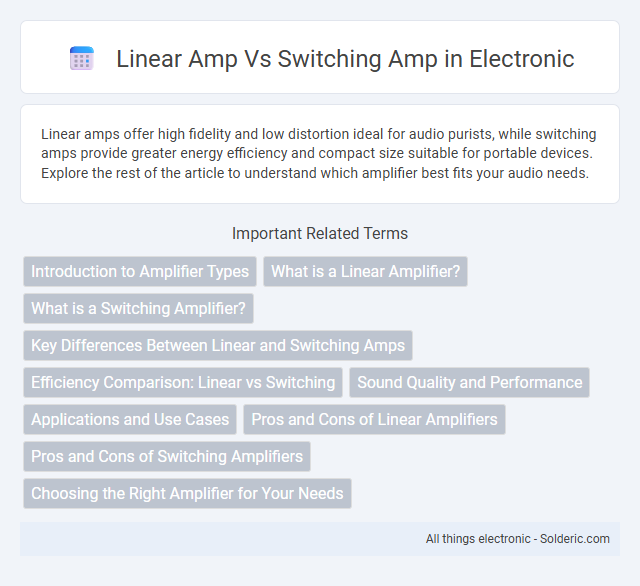Linear amps offer high fidelity and low distortion ideal for audio purists, while switching amps provide greater energy efficiency and compact size suitable for portable devices. Explore the rest of the article to understand which amplifier best fits your audio needs.
Comparison Table
| Feature | Linear Amplifier | Switching Amplifier |
|---|---|---|
| Efficiency | Low (typically 20-30%) | High (up to 90%+) |
| Heat Generation | High heat dissipation | Low heat output |
| Sound Quality | High fidelity, low distortion | Good, but may introduce noise |
| Complexity | Simple design | Complex circuitry |
| Size & Weight | Bulky and heavy | Compact and lightweight |
| Cost | Higher manufacturing cost | Lower cost due to fewer materials |
| Typical Applications | High-end audio, studio monitors | Portable devices, car audio |
| Power Output | Moderate power | High power capability |
Introduction to Amplifier Types
Linear amplifiers operate by continuously varying the output transistor's conduction to replicate the input signal, delivering high fidelity audio with low distortion but generating more heat due to inefficiency. Switching amplifiers, often called Class D amps, rapidly switch output transistors on and off, achieving higher efficiency and smaller size while requiring advanced filtering to reduce switching noise. Understanding these fundamental amplifier types is crucial for applications demanding either audio quality or power efficiency.
What is a Linear Amplifier?
A linear amplifier is an electronic device designed to amplify an input signal with minimal distortion, maintaining the signal's original waveform and frequency integrity. It operates by continuously varying its output in direct proportion to the input, making it ideal for high-fidelity audio and RF applications where signal purity is crucial. Unlike switching amplifiers, linear amplifiers offer superior linearity but typically consume more power and generate greater heat.
What is a Switching Amplifier?
A switching amplifier, also known as a Class D amplifier, uses high-frequency switching transistors to convert the input signal into a series of pulses, improving energy efficiency and reducing heat generation compared to linear amps. These amplifiers are ideal for applications requiring high power output with minimal size and weight, such as portable audio devices and automotive sound systems. Your audio setup will benefit from a switching amplifier's ability to deliver powerful sound while maintaining lower energy consumption.
Key Differences Between Linear and Switching Amps
Linear amps operate by continuously varying their output transistors to amplify signals with minimal distortion, resulting in high-fidelity sound but lower efficiency and increased heat generation. Switching amps, or Class D amplifiers, rapidly switch output transistors on and off to achieve high power efficiency and reduced heat, though they may introduce more signal distortion compared to linear amps. Understanding these key differences helps you choose the right amplifier based on your audio quality needs and power consumption preferences.
Efficiency Comparison: Linear vs Switching
Switching amplifiers demonstrate significantly higher efficiency, often exceeding 80-90%, by rapidly toggling transistors on and off to minimize power loss. Linear amplifiers typically exhibit efficiencies between 20-30% due to continuous current flow and heat generation during signal amplification. This efficiency difference directly impacts thermal management, power consumption, and overall system design in audio and RF applications.
Sound Quality and Performance
Linear amplifiers deliver superior sound quality with low distortion and a smooth, natural audio output, making them ideal for audiophiles seeking high-fidelity performance. Switching amplifiers boast higher efficiency and generate less heat, but may introduce switching noise that can slightly affect audio clarity. Your choice depends on whether you prioritize pristine sound reproduction or energy-efficient operation.
Applications and Use Cases
Linear amplifiers excel in high-fidelity audio applications, such as professional music production and broadcasting, where signal purity and low distortion are critical. Switching amplifiers are favored in power-efficient applications like portable devices, wireless communication, and electric vehicles, offering high power output with minimal heat dissipation. Your choice depends on whether audio quality or energy efficiency is the priority in your specific use case.
Pros and Cons of Linear Amplifiers
Linear amplifiers offer superior audio fidelity and low distortion, making them ideal for high-quality sound applications such as professional audio and radio transmission. However, they tend to be less energy-efficient and generate more heat compared to switching amplifiers, leading to larger size and heavier weight. Your choice depends on prioritizing sound quality and signal accuracy over power efficiency and compactness.
Pros and Cons of Switching Amplifiers
Switching amplifiers offer high energy efficiency, often exceeding 90%, which reduces heat generation and allows for compact designs ideal for portable devices. However, they can introduce electromagnetic interference (EMI) and signal distortion due to their high-frequency switching operation, potentially affecting audio fidelity. Despite these drawbacks, advancements in digital signal processing and filtering have significantly improved the sound quality of switching amplifiers, making them popular in modern audio applications.
Choosing the Right Amplifier for Your Needs
Linear amplifiers offer superior sound quality and low distortion, making them ideal for audiophiles and professional audio applications. Switching amplifiers provide higher efficiency and compact size, which suits portable or power-sensitive setups. Your choice depends on whether sound fidelity or energy efficiency is your priority.
linear amp vs switching amp Infographic

 solderic.com
solderic.com